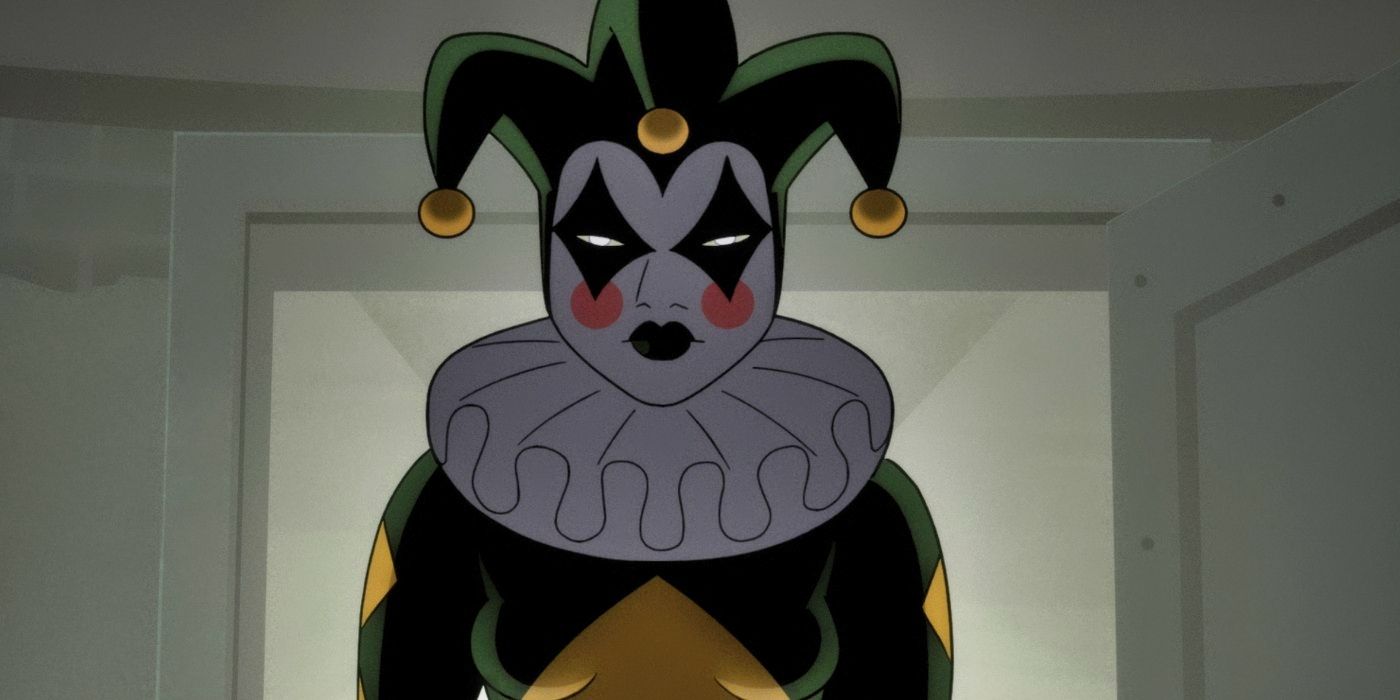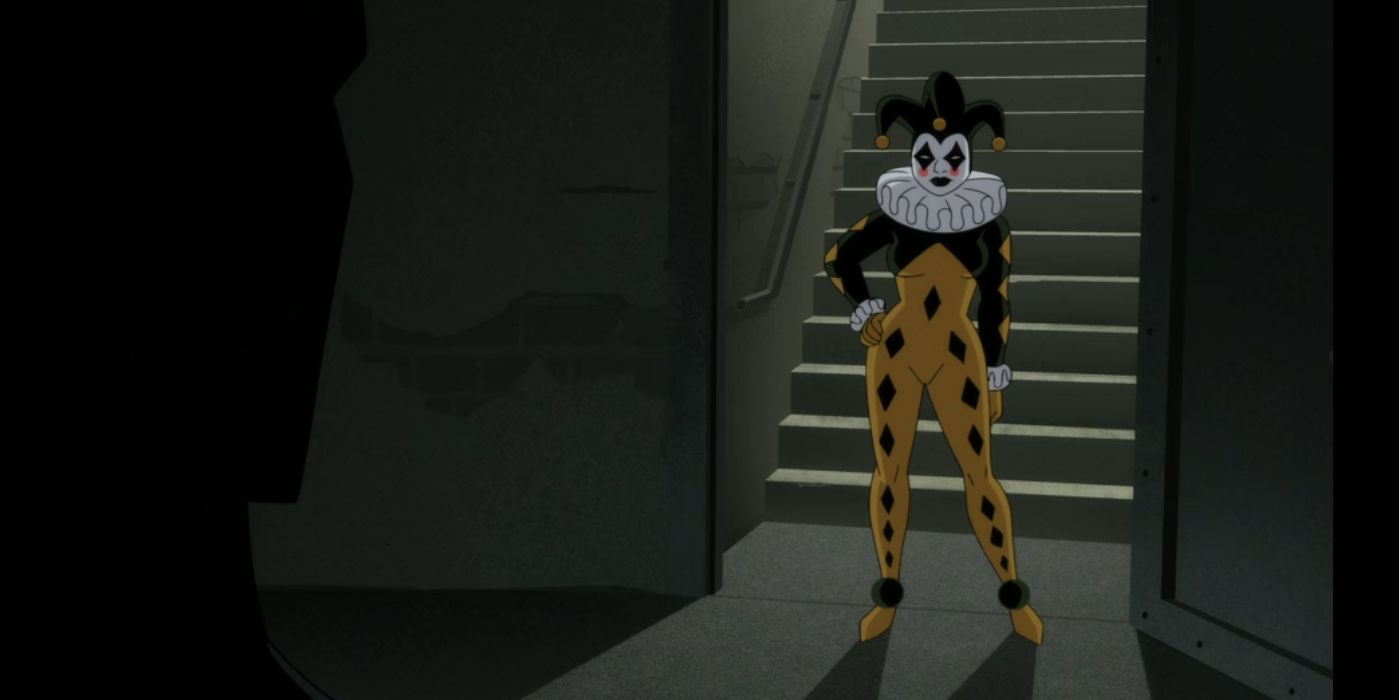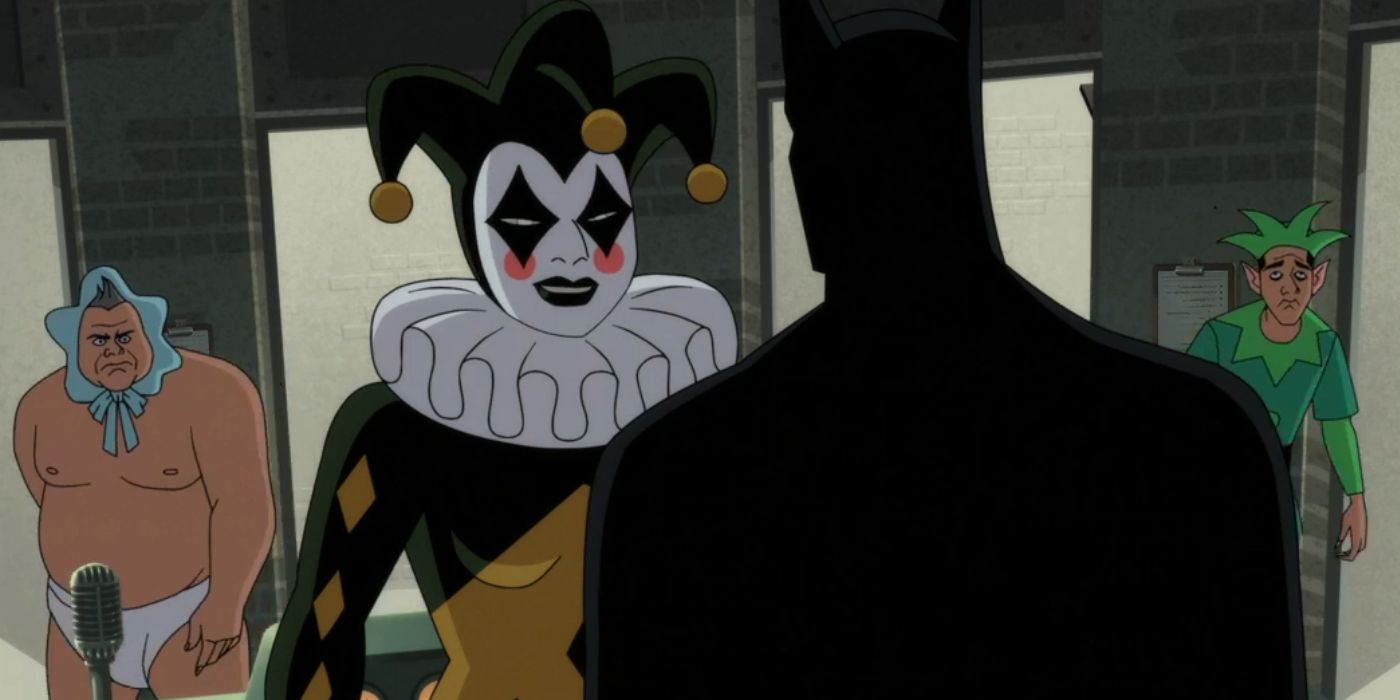
Things are finally shaking up in Gotham City. Despite its classic aesthetic, Prime Video’s newest animated series, Batman: Caped Crusader, is anything but old-fashioned, introducing audiences to new twists on classic villains that keep even Batman’s most recognizable rogues interesting. From a gender-swapped Penguin (Minnie Driver) to Batman: Caped Crusader‘s surprisingly compassionate take on Harvey Dent, the latest Batman project from longtime DC mastermind Bruce Timm and executive producer Matt Reeves balances nostalgia with original storylines, with the series’ most refreshing innovation being the updated origin story of Gotham’s cheeriest psychiatrist, Harley Quinn (Jamie Chung).
Given a merciful break from Arkham by Batman: Caped Crusader‘s creative team, Dr. Harleen Quinzel is instead introduced in Episode 3, “Kiss of the Catwoman,” as a popular psychiatrist with a successful public practice. Often taking clients referred to her by Barbara Gordon’s (Krystal Joy Brown) caseload as a public defender, Quinzel even briefly examines Hamish Linklater‘s Bruce Wayne in Batman: Caped Crusader, with the notoriously emotionally unavailable superhero taking therapy about as well as one would expect. However, when several prominent Gotham tycoons begin giving away all their assets and going missing in Episode 5, “The Stress of Her Regard,” Batman is nonetheless compelled to take a closer look at Dr. Quinzel’s practice, with the episode rounding out Harley’s story in Caped Crusader by making several improvements to the supervillain’s iconic origins.
In Gotham City, where corruption and crime are rampant, wealthy socialite Bruce Wayne transforms into Batman following a personal tragedy. His relentless pursuit of justice attracts unexpected allies within the GCPD and City Hall, but also spawns deadly consequences. This series reimagines Batman’s mythology through the creative lenses of J.J. Abrams, Matt Reeves, and Bruce Timm.
Harley Quinn Walks Her Own Path to Villainy in ‘Batman: Caped Crusader’
In the past, Harley’s origins have not been solely her own, with the character’s transformation from dedicated psychiatrist to hammer-swinging, unhinged harlequin often attributed to the Joker’s manipulations ever since The New Batman Adventures adapted the storyline in Episode 24, “Mad Love.” An Arkham doctor who falls under the sadistic clown’s abusive spell, Harley is largely portrayed as a victim of the Joker’s ability to garner false sympathy with his unverifiable backstories, someone who plays the role of sidekick and mistreated love interest during Harley Quinn’s episodes in Batman: The Animated Series because of a misplaced sense of conditional love. Recently, more empowered incarnations of Harley Quinn have asserted their independence during Margot Robbie‘s tenure as the character and Max‘s successful Harley Quinn series, but Batman: Caped Crusader takes things one step further by removing Joker from Harley’s backstory completely.
While the series doesn’t reveal when its own Dr. Quinzel first began her descent into villainy, Batman: Caped Crusader‘s Harley is in full control of her schemes in Episode 5. Rather than relying on the Joker’s chaotic gags and body-breaking props to wage a war against Gotham’s hypocrisy, this unsettling clown utilizes her own specialties to achieve her goals. Having imprisoned high-profile members of Gotham’s elite in her own personal playpen, Dr. Quinzel exploits her psychiatric training to mentally torment her victims into obeying her will, taking advantage of each man’s insecurities and internal crises to achieve compliance. And while Joker does make a surprise cameo in Batman: Caped Crusader‘s finale, by that time Harley has already fled the city, demonstrating the separate stature attributed to each of Gotham’s jester-themed rogues.
‘Batman: Caped Crusader’ Offers a More Serious, Sympathetic Harley Quinn


As a result of the distance between Harley and Joker in the show, Batman: Caped Crusader gives Dr. Quinzel more room to develop her own version of her iconic persona, resulting in a unique Harley Quinn that departs from the character’s typically humorous tone. Donning a darker costume and unfeeling, monotone voice in her interactions with her kidnapped patients, Chung’s latest take on the Batman villain feels dark and gritty, as menacing when she’s forcing her prisoners to write endless lines on a chalkboard as she is brutal in doling out their punishments. Yet, aside from how unnerving it is to watch this Harley repurpose her classic “pudding” line into a reward for her prisoners beating each other close to death, Batman: Caped Crusader also does more than most Batman properties to give Harley a relatable reason for attacking Gotham.
Rather than using unrequited romance or a broad desire for chaos as a character motivation, Timm’s newest animated Batman series uses Dr. Quinzel’s difficult profession as a justification for her extreme actions. After being forced to listen to some of Gotham’s most selfish CEOs mistreat their family members and take advantage of the city, Quinzel’s more restrained, therapeutic persona gets fed up with how none of Gotham’s elite seem to learn from their actions, taking matters into her own hands by brainwashing them into the charity they couldn’t bring themselves to embrace on their own. As a result, Batman: Caped Crusader‘s Harley almost comes off as a psychiatric Robin Hood in Timm and Reeves’ Batman reboot, with the antagonist fighting social inequality by trying to give back what never should have been hoarded in the first place. What’s more, despite the cruelty Harley applies to her incarcerated misers, the series never allows herto stray completely down the path of one-dimensional evil.
‘Batman: Caped Crusader’ Adds a Heartwarming Layer to Harley’s Personality
Ironically, even though Dr. Quinzel’s alter-ego is a notoriously whimsical harlequin, the character’s most lighthearted moments in Batman: Caped Crusader occur when she’s interacting with Barbara and Detective Renee Montoya (Michelle C. Bonilla). In another refreshing revision to Harley’s origins, Quinzel’s early days don’t feature the Dark Knight’s deadliest enemy so much as positive female friendships, with the three women supporting each other’s mental health and careers throughout early installments of the series. In Episode 5, Quinzel’s date with Montoya even gives her the chance to show off her more caring, romantic side, allowing Timm’s series to round out Harley’s origins by depicting both the crime and compassion at the heart of her personality.
The episode’s climax best represents how Harley’s sincere concern clashes with her villainous turn in Timm’s series. After successfully trapping Batman in her playpen and setting her hideout to self-destruct, Harley halts her own successful escape from the premises once she realizes Barbara has also infiltrated her hideout. This causes Harley to risk her own life in order to save one of her best friends as the building goes up in flames, with the psychiatrist ultimately letting go of Barbara’s hand as she dangles from the cliff in a visual homage to Harley Quinn’s death scene in Batman Beyond: Return of the Joker. And even though the episode’s final scene confirms Harley survived her plunge into the sea when she calls Montoya at a phone booth, Harley’s willingness to risk her life for a girlfriend still adds a heroic undertone to the character’s otherwise villainous episode.
By giving fans this glimpse into the character’s more altruistic side while also allowing Harley’s psychological expertise and social awareness to shine, Batman: Caped Crusader hints at Harley’s anti-hero status while delivering a compelling rewrite of her already iconic origins. With Joker’s absence, Harley and her personal relationships take center stage in Bruce Timm’s latest adaptation, allowing the showrunner to expand on a character rapidly eclipsing the popularity of her original puddin’. Not only does Harley’s most recent outing present modern audiences with a more layered, personal depiction of one of Batman’s best animated villains, but Harley’s escape at the end of Episode 5 also opens the door for the show’s dark, conflicted take on the character to continue to grow in future episodes.
Batman: Caped Crusader is available to stream on Prime Video in the U.S.




